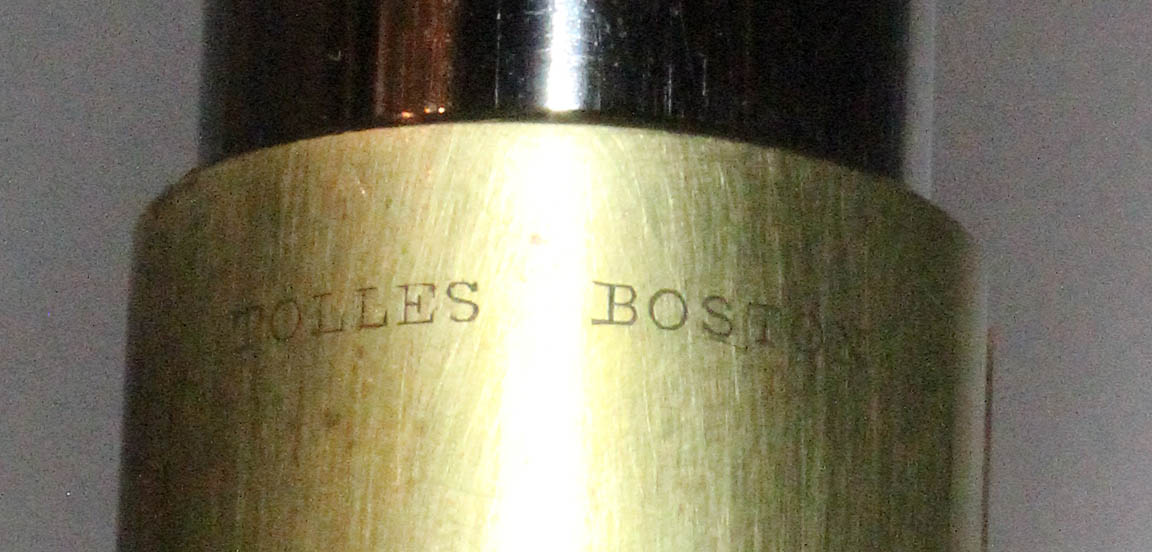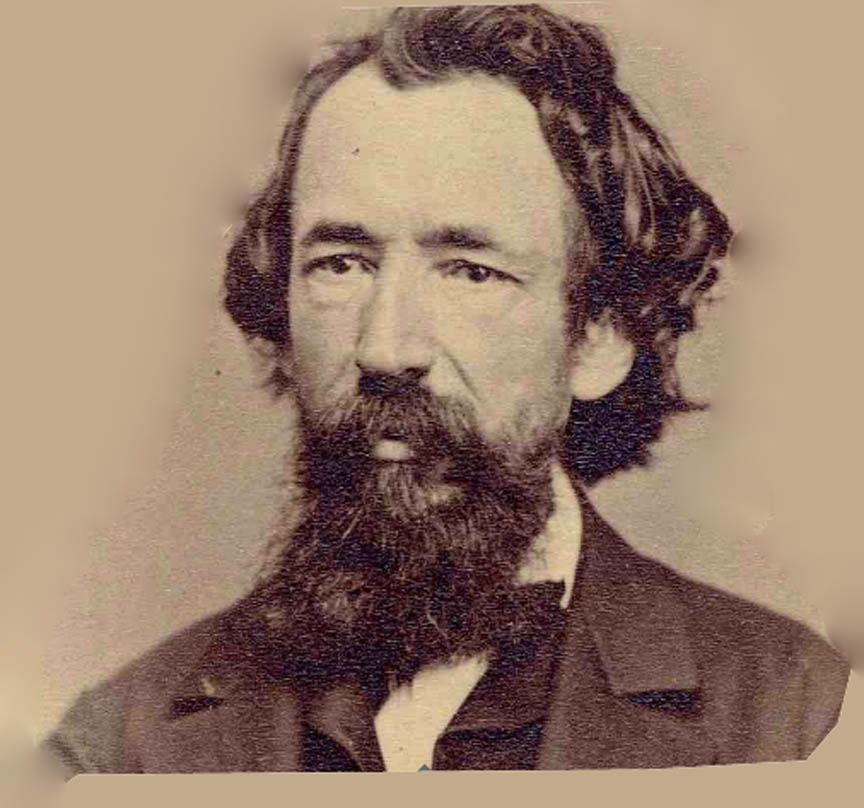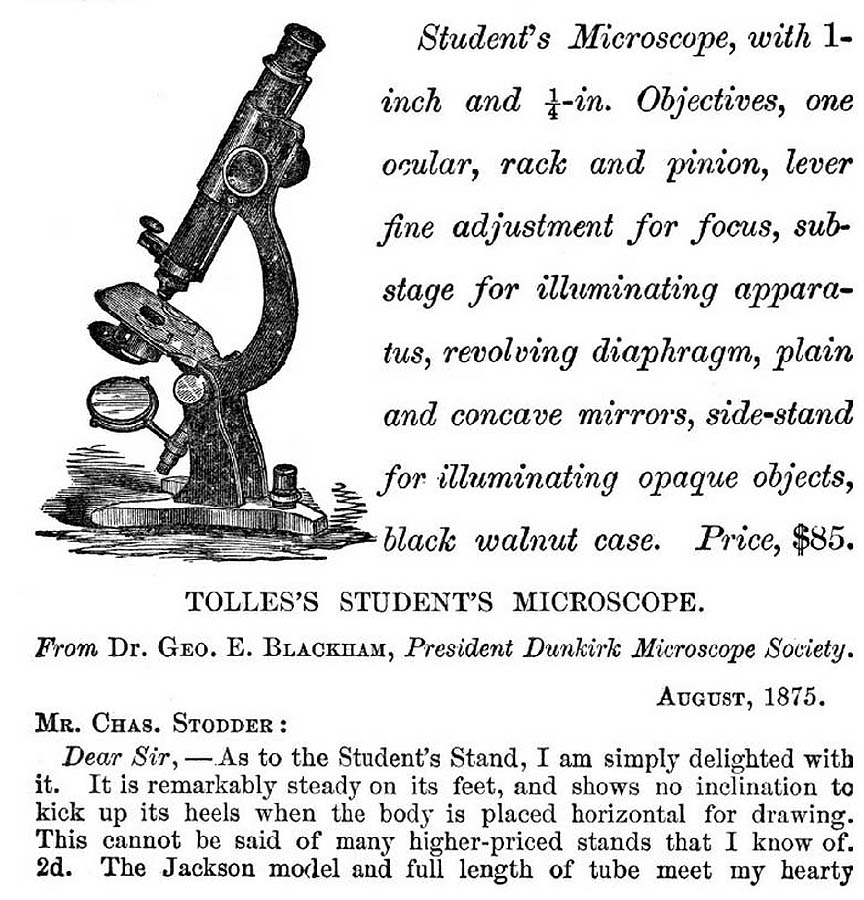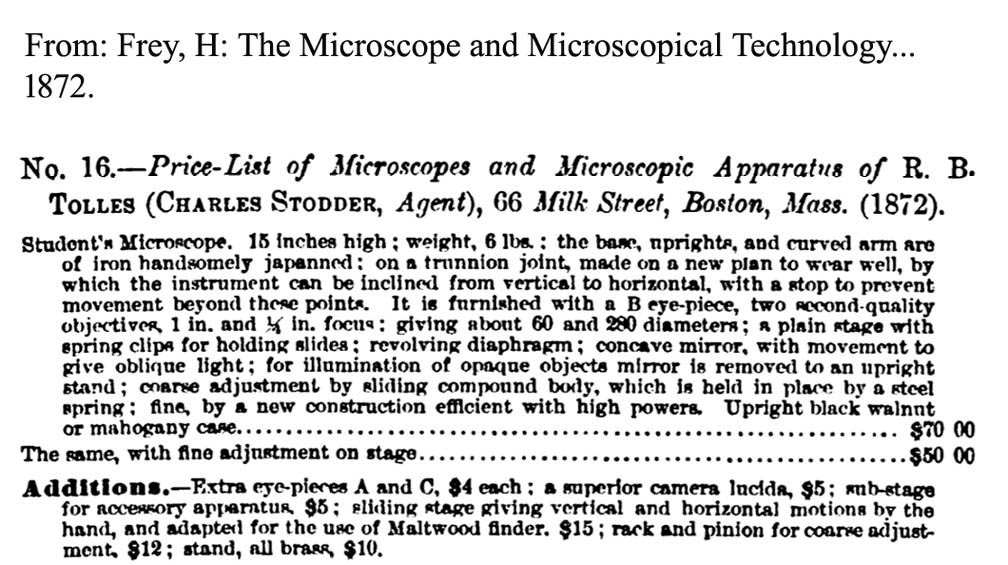MICROSCOPE-ANTIQUES.COM © 2013-21.
TOLLES MICROSCOPE
YEAR: c. 1880
SIGNED: TOLLES, BOSTON
SERIAL NUMBER: 232
MODEL: STUDENT
DESCRIPTION:
 This microscope, signed
This microscope, signed Tolles, Boston
on the outer tube sleeve,
arises from a wavy Y-shaped
foot* (this shape seen on earlier Grunow and Spencer Microscopes), with the limb supported by a trunnion joint between twin
plates, similar to many large Ross microscopes. The Lister-Limb has a
distinctive shape, roughtly triangular in cross section with rounded points, becoming narrower as it
rises, and with rounded edges.* It is technically an isosceles
trapezoid with slightly rounded edges
(thanks to Paul Ferraglio for
this more accurate description). The scope has some features which were
additional-cost options, including its all lacquered brass
construction, and a rack and pinion coarse focus, instead of the
standard sliding coarse focus**. It came equipped with the standard
complement of one inch and 1/4 inch focal length objectives, side
stand for illuminating opaque objects,
and a walnut case. In use for
observing opaque objects, as shown on the images above, the mirror unit
is removed from the tailpiece and slides on to the side stand.
The serial number is stamped both
on the underside of the foot and also the underside of the stage. There
is a wheel of apertures to adjust the diameter of the light cone coming
up through the specimen. The coarse focusing arrangement is a bit
unusual in that the rack wraps around
the sleeve in which the optical
tube moves. The rack is pressed up against, and rides up and down on,
the flattened back side of that sleeve as the knob turning the pinion
is used to raise or lower it. There is an adjustment screw which can
vary the distance between the pinion casing and the rack to adjust the mesh of gears. The optical
tube is made of polished nickel-plated brass and is of fixed length with no draw
tube. There is a single ocular and the original walnut case. The
tailpiece is fixed. Tension on the trunnion joint is adjustable. The
finely threaded fine-focus knob acts on a sprung nickel-plated top plate of the stage, tilting it up or down from the rear, the
front end being fixed to the front edge of the stage; there is no hinge, it simply bends at the front with adjustment of the fine focusing knob. There are two original
stage clips.
*Several features of Tolles microscopes can be traced back to earlier models by American and other Makers. Charles
Spencer's company as well as Grunow uses similar shaped feet and uprights. The unusual cross-sectional shape of a rounded isosceles triangle was used on early Spencer microscopes (including the time that Tolles worked for him), then Tolles, the Boston Optical Works, and
Charles X. Dalton, Tolles successor. Spencer eventually changed the limb
shape to a more traditional rectangular cross section, while Tolles retained the rounded triangular cross section.
**Most surviving examples have a cast iron foot, uprights, and supports to the outer tube sleeve. The use of lacquered brass for the entire stand was an option at additional cost and is seldom seen in surviving examples.
HISTORY OF THE TOLLES STUDENT MODEL AND ROBERT TOLLES

 Robert Tolles was a remarkable man who grew up without means. He could
not afford to attend college, but instead when old enough, set out to find a suitable employment. On his journey he happened to pass through Canastota, New York and came across the workshop of the famous and very talented Charles Spencer. He immediately decided this was the profession for him and he stayed as an apprentice and then workman for Spencer, spending about fourteen years with Spencer.
Robert Tolles was a remarkable man who grew up without means. He could
not afford to attend college, but instead when old enough, set out to find a suitable employment. On his journey he happened to pass through Canastota, New York and came across the workshop of the famous and very talented Charles Spencer. He immediately decided this was the profession for him and he stayed as an apprentice and then workman for Spencer, spending about fourteen years with Spencer.
In 1858 Tolles went into business on his own in Canastota, and by 1867 had moved to Boston to superintend the Boston Optical Works (BOW). As noted above, Tolles continued to use the profile of the foot and limb that was used at Spencer when Tolles was working there. In fact, the Tolles Student Microscope has a striking resemblance to a similar microscope by C.A. Spencer & Son of about 1870. The BOW was dissolved as an entity about 1872 but Tolles continued to run the business, while Charles Stoddder, the founder of the BOW continued to sell Tolles products. Charles X. Dalton was working with Tolles at the Spencer company and followed him to the BOW.
Tolles died in 1883, and Dalton ran the company until it ceased operations. Tolles, a talented optician, produced relatively few stands compared to the number of optical parts that he fabricated. The reason for this was obvious as he was fascinated and obsessed with improvement of the optics of microscopes. This talent resulted in some of the best optics
ever made and, among other things, the invention of oil immersion objectives. He did produce some well made microscope stands. Among the most plentiful of these still in existence are his student stands, including several variations of the one shown on this web page.
The student model was exhibited and noted in the proceedings of the American Association for the Advancement of Science in 1870, and continued to be noted and was reported (and pictured) as late as 1884 in the Journal of the Royal Microscopical Society. Even in 1872, as shown below in the price list from Frey, several optional features were available and included a fine adjustment of new construction
or for $20 less, the microscope was supplied with the tilting stage fine adjustment seen on the microscope on this web page. The more costly fine adjustment was apparently too expensive for most buyers as most student models which still exist have the tilting-stage type of fine adjustment.

 This microscope, signed
This microscope, signed 
 Robert Tolles was a remarkable man who grew up without means. He could
not afford to attend college, but instead when old enough, set out to find a suitable employment. On his journey he happened to pass through Canastota, New York and came across the workshop of the famous and very talented Charles Spencer. He immediately decided this was the profession for him and he stayed as an apprentice and then workman for Spencer, spending about fourteen years with Spencer.
Robert Tolles was a remarkable man who grew up without means. He could
not afford to attend college, but instead when old enough, set out to find a suitable employment. On his journey he happened to pass through Canastota, New York and came across the workshop of the famous and very talented Charles Spencer. He immediately decided this was the profession for him and he stayed as an apprentice and then workman for Spencer, spending about fourteen years with Spencer.